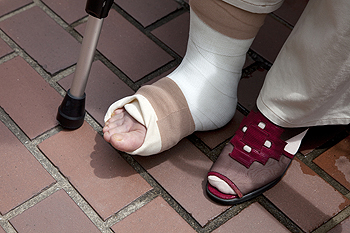Symptoms of a Broken Foot
Monday, 28 January 2019 00:00 If you have fallen or dropped a heavy object on your foot, the result may be a broken foot. There are typically noticeable symptoms that are associated with this condition, and these may include severe pain and discomfort that is felt while attempting to walk, and possible swelling and bruising. If the fracture is severe, and appears to be dislocated, it may be a result of bones that are out of alignment. Patients who have medical conditions which may include diabetes or peripheral neuropathy, may not notice if their foot is fractured, and this may be a result of a loss of sensation. Once a proper diagnosis is performed, which typically consists of having an X-ray taken, the correct treatment can begin. This may include resting and elevating the foot as often as possible, and wearing a cast or protective boot while the healing process takes place. For more severe fractures, an MRI might be a necessary test to aid in determining the severity of the fracture. If you feel you have broken your foot, it is suggested that you consult with a podiatrist as quickly as possible so the proper treatment can begin.
If you have fallen or dropped a heavy object on your foot, the result may be a broken foot. There are typically noticeable symptoms that are associated with this condition, and these may include severe pain and discomfort that is felt while attempting to walk, and possible swelling and bruising. If the fracture is severe, and appears to be dislocated, it may be a result of bones that are out of alignment. Patients who have medical conditions which may include diabetes or peripheral neuropathy, may not notice if their foot is fractured, and this may be a result of a loss of sensation. Once a proper diagnosis is performed, which typically consists of having an X-ray taken, the correct treatment can begin. This may include resting and elevating the foot as often as possible, and wearing a cast or protective boot while the healing process takes place. For more severe fractures, an MRI might be a necessary test to aid in determining the severity of the fracture. If you feel you have broken your foot, it is suggested that you consult with a podiatrist as quickly as possible so the proper treatment can begin.
A broken foot requires immediate medical attention and treatment. If you need your feet checked, contact Dr. Lee R. Stein from Lake Shore Foot & Ankle, PC. Our doctor can provide the care you need to keep you pain-free and on your feet.
Broken Foot Causes, Symptoms, and Treatment
A broken foot is caused by one of the bones in the foot typically breaking when bended, crushed, or stretched beyond its natural capabilities. Usually the location of the fracture indicates how the break occurred, whether it was through an object, fall, or any other type of injury.
Common Symptoms of Broken Feet:
- Bruising
- Pain
- Redness
- Swelling
- Blue in color
- Numbness
- Cold
- Misshapen
- Cuts
- Deformities
Those that suspect they have a broken foot shoot seek urgent medical attention where a medical professional could diagnose the severity.
Treatment for broken bones varies depending on the cause, severity and location. Some will require the use of splints, casts or crutches while others could even involve surgery to repair the broken bones. Personal care includes the use of ice and keeping the foot stabilized and elevated.
If you have any questions please feel free to contact one of our offices located in Chicago, Highland Park, and Uptown, IL . We offer the newest diagnostic and treatment technologies for all your foot and ankle needs.
Featured Articles
- April 2025
- March 2025
- February 2025
- January 2025
- December 2024
- November 2024
- October 2024
- September 2024
- August 2024
- July 2024
- June 2024
- May 2024
- April 2024
- March 2024
- February 2024
- January 2024
- December 2023
- November 2023
- October 2023
- September 2023
- August 2023
- July 2023
- June 2023
- May 2023
- April 2023
- March 2023
- February 2023
- January 2023
- December 2022
- November 2022
- October 2022
- September 2022
- August 2022
- July 2022
- June 2022
- May 2022
- April 2022
- March 2022
- February 2022
- January 2022
- December 2021
- November 2021
- October 2021
- September 2021
- August 2021
- July 2021
- June 2021
- May 2021
- April 2021
- March 2021
- February 2021
- January 2021
- December 2020
- November 2020
- October 2020
- September 2020
- August 2020
- July 2020
- June 2020
- May 2020
- April 2020
- March 2020
- February 2020
- January 2020
- December 2019
- November 2019
- October 2019
- September 2019
- August 2019
- July 2019
- June 2019
- May 2019
- April 2019
- March 2019
- February 2019
- January 2019
- December 2018
- November 2018
- October 2018
- September 2018
- August 2018
- July 2018







